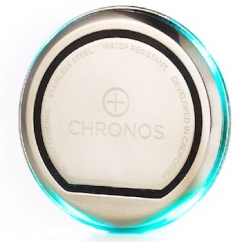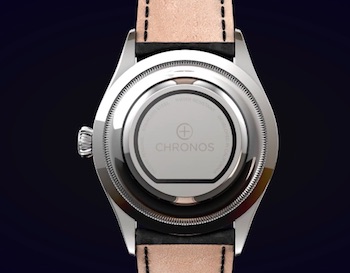Articles and News
Smartwatches Bite Luxury Watch Industry Hard, But New Device May Save Sales | February 24, 2016 (0 comments)

Merrick, NY—While watch industry pundits firmly believe that smartwatches will lure young consumers away from their phones and into the world of timepieces—where they will next trade up to luxury—right now smartwatches are stirring up some very ugly memories of the 1970s when digital and quartz watches decimated the market for fine mechanical watches. Sales figures show smartwatches already have taken a huge bite out of the luxury watch market, and all signs point to a continued feast.
Meanwhile, a new device that turns any watch into an instant smartwatch may just save the luxury watch industry’s backside—literally.
First the bad news: Smartwatches outsold Swiss made watches in 2015, overtaking luxury timepieces for the first time ever.
According to numbers from market research firm Strategy Analytics and reported on Wareable.com, global shipments of smartwatches passed Swiss watches in the fourth quarter of 2015. 8.1 million smartwatches were shipped in the fourth quarter of 2015, compared to 7.9 million Swiss watches, a deficit of 200,000 units. The Swiss watch figures also show a 5% year-on-year decline for the same quarter, and things aren’t looking up. According to official figures from the Federation Of The Swiss Watch Industry, Swiss watch exports in January 2016 fell 7.9% by value from January 2015.
Meanwhile, smartwatch sales rocketed 316% in Q4 2015. While such huge percentage increases are common with any new category—after all, they’re starting from a relatively zero base—unit sales of just the Apple watch alone far outpaced total unit sales of all Swiss watches. Though Apple Watch sales might not have hit original projections, an estimated 12 million units were sold in 2015; 4.1 million more than all Swiss watches combined.
So why are the traditional luxury watch sales slumping? Sales fell off most notably in Hong Kong—where the economy easily could be blamed—but also in the United States, where it shouldn’t be.
Neil Mawston, executive director at Strategy Analytics told Wareable.com, "The Swiss watch industry has been very slow to react to the development of smart watches…sticking its head in the sand and hoping smart watches will go away."
Another telling sign: luxury conglomerate Richemont is considering cutting up to 350 jobs in Switzerland. The group, which includes such brands as Piaget, Vacheron Constantin, and Cartier, on Monday confirmed a report in Swiss newspaper Le Temps that said the company would be cutting up to 4% of its Swiss workforce of about 9,000, in what analysts say could signal a lasting weakness in the Swiss watch industry.
"Richemont would not consider jobs cuts in its production facilities if it was foreseeing an imminent rebound in the watch industry, in our view," analysts at JPMorgan Cazenove said in a note on Monday. "Watch production employees are skilled craftsmen, and it takes time to train them."
A handful of Swiss companies have embraced tech, such as Frederique Constant’s Horological Smartwatch and TAG Heuer, which launched its first Connected smartwatch late last year and has had to ramp up production to meet demand. Both Bvlgari and Hublot are the first of what’s expected to be a host of high-end watches that will be able to make mobile payments. MasterCard is working with NFC firm WISeKey, to develop the ability to make contactless payments from high-end watches.
Now the good news: A company called Chronos, based in San Franscisco, has invented a device that capable of turning just about any watch into a smartwatch. “The best wearable is the one you already wear,” says its website. Indeed, the company’s Millennial-age founders, Mark Nichol and Luke Fromowitz—both luxury watch owners—got the idea the way many entrepreneurs do: trying meet their own needs. CEO Nichol, whose favorite watch is a Rolex GMT, wanted to track his health but didn’t like how fitness bands looked next to it. CTO (chief technology officer) Fromowitz, whose pedigree includes product design time at Navistar, Raytheon, and Samsung, was looking for the perfect wearable to go with his Omega Seamaster Aquaterra. Not finding it, he built it himself.
The device—which launches this spring—is a flat disk (pictured top of page) that attaches via suction to the underside of the watch’s case (below), and works on both mechanical and quartz models. Users then can control their phone—such as calendar and call notifications, skipping music tracks, and much more, with a tap on their watch. The accompanying Chronos app lets users customize how they set up the device for their own needs, and it also works as a fitness tracker.

Early reviews (on Bloomberg.com and Hodinkee) have been positive all around: fit, functionality, price, and customer appeal. Unlike most beta-tests, reviewers said the device worked without a hitch and paired seamlessly with the iOS health and notifications apps. (An Android version also is due out this spring.) The company’s own website shows a multitude of customizable options for notifications.
The only potential downside is that the device does add 2.5 mm of thickness to a watch, and it is best used with a plain flat-back case rather than a domed, curved, or ornately engraved one. Metal bracelets may require sizing up to accommodate it.
MSRP is $129, but at press time the Chronos website offered a pre-sale price of $89. It also was unclear at press time if the device will be available for wholesale distribution through retail jewelers.







